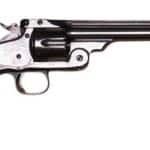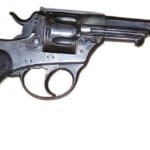Imprinted on the annals of firearms history is an array of .45 caliber cartridges, each offering a distinctive narrative, operational utility, and ballistic individuality. This extensive piece embarks on a journey through seven prominent .45 caliber cartridges: the .45 Colt, .45 Schofield, .45-70 Government, .45-75, .45 ACP, .45 Auto-rim, .45 GAP, .455 Webley, and the .454 Casual. We will shed light on the evolution from black powder to smokeless powder and discuss famous firearms associated with each cartridge.
.45 Colt
Heralded from 1872 and built for the iconic Colt Single Action Army revolver, the .45 Colt is deeply ingrained in firearm lore. Often termed the .45 Long Colt, this .45 caliber cartridge originally utilized a substantial 255-grain bullet backed by 40 grains of black powder, blasting out at around 900 feet per second (fps). As smokeless powder became the norm, the cartridge transitioned smoothly, maintaining its status as a reliable, powerful round.
The .45 Colt's raw power and pinpoint accuracy made it a stalwart among cowboy action shooters and hunters. However, the cartridge's length may limit its utility in some modern weapons. The original Colt Single Action Army revolver, the figurehead for this cartridge, holds a legendary status in the American West. Contemporary revolvers like the Ruger Blackhawk and Redhawk continue the tradition, harnessing the .45 Colt's power to its fullest.
.45 Schofield
In the mid-1870s, Smith & Wesson crafted the .45 Schofield for their Model 3 Schofield Revolver. Shorter than the .45 Colt, this .45 caliber cartridge was initially adopted by the U.S. Cavalry. Packed with a 230-grain bullet and 28 grains of black powder, it achieved a muzzle velocity of approximately 730 fps. As black powder gave way to smokeless, the .45 Schofield remained a viable, slightly less potent alternative to the .45 Colt.
Despite being outmatched in power by the .45 Colt, the .45 Schofield earned its stripes through manageable recoil. While it's not a commonly used round today, it maintains a dedicated following among history aficionados and firearm collectors. The Schofield Revolver, the original platform for this cartridge, remains an attractive piece of historical and functional design.
.45-70 Government
The year 1873 marked the U.S. military's adoption of the .45-70 Government, designed for use in the Springfield Model 1873 rifle. This cartridge differs from the others discussed here as it's a rifle round. Initially, this large .45 caliber cartridge housed a hefty 405-grain lead bullet propelled by 70 grains of black powder, reaching muzzle velocities of about 1,350 fps. The .45-70 Government made a successful transition to smokeless powder, solidifying its place in the pantheon of powerful, reliable hunting cartridges.
The .45-70 Government's high firepower makes it ideal for hunting large game at close to medium ranges. Yet, its pronounced recoil and parabolic trajectory can be challenging, rendering it less suitable for long-range shooting. Despite these challenges, modern rifles like the Marlin Model 1895 and the Henry H010 still chamber this cartridge, attesting to its enduring popularity among hunting enthusiasts.
.45-75 Winchester
Introduced in the U.S. Centennial year of 1876, the .45-75 Winchester was a .45 caliber cartridge developed as the inaugural cartridge for the Winchester Model 1876 Centennial Rifle. The original design featured a 350-grain bullet powered by 75 grains of black powder, delivering a muzzle velocity of around 1,375 fps. As smokeless powder began to dominate, the .45-75 Winchester didn't fare as well in the transition, contributing to its decline.
Though formidable in its heyday, the .45-75 Winchester's adoption was restricted, and it became somewhat obscure in the face of more modern, smokeless powder cartridges. Its presence today is largely limited to antique firearms and cartridge collectors. Despite its reduced prominence, it holds an essential place in the development of lever-action rifle cartridges.
.45 ACP (Automatic Colt Pistol)
The brainchild of John M. Browning in 1905, the .45 ACP was officially adopted by the U.S. military in 1911. It was designed around the then-emerging technology of smokeless powder, marking a departure from the previous cartridges in this list. Initially, it was loaded with a 200-grain bullet, delivering speeds of about 900 fps. Modern iterations most commonly feature a 230-grain bullet at similar velocities. This is the round most people thing of when they think of .45 caliber cartridges.
The .45 ACP is famed for its impressive stopping power, making it a favored choice among military, law enforcement, and civilian users for self-defense and competition shooting. However, due to its large size, magazine capacity can be an issue when compared to smaller calibers. The M1911 pistol, a product of Browning's genius, remains one of the most iconic firearms chambered in .45 ACP, with numerous modern firearms, such as the Glock 21 and the HK USP, continuing the legacy.
.45 Auto-rim
The .45 Auto-rim emerged in 1920 as a solution for the difficulty in ejecting .45 ACP cartridges in revolvers. The auto-rim cartridge features a thicker rim that eliminates the necessity for moon clips in revolvers chambered for the .45 ACP. It typically propels a 200 to 230-grain bullet at velocities similar to the .45 ACP.
While not as common today, the .45 Auto-rim is still appreciated by some revolver enthusiasts due to its convenience. The Smith & Wesson Model 625, a classic revolver, is an example of a firearm that can utilize the .45 Auto-rim to its potential.
.45 GAP (Glock Automatic Pistol)
Glock developed the .45 GAP to provide an alternative to the .45 ACP with a more compact size, catering to smaller framed handguns while still delivering comparable performance. A relatively modern cartridge, the .45 GAP has always been loaded with smokeless powder. It pushes a 185 to 230-grain bullet, matching the .45 ACP's common muzzle velocities.
The .45 GAP offers a significant stopping power similar to the .45 ACP, but in a smaller package. This allows for a higher capacity in compact handguns, addressing one of the .45 ACP's drawbacks. Glock’s own models like Glock 37, 38, and 39 were the trailblazers for this cartridge, yet its adoption hasn't been as widespread, largely due to the continued popularity and availability of .45 ACP
.454 Casull
An additional heavyweight in the .45 caliber landscape is the .454 Casull. Devised in 1957 by Dick Casull and Jack Fullmer, the .454 Casull was designed to be a high-power, long-range handgun cartridge. Its significantly higher pressure load compared to the .45 Colt from which it was developed allows the .454 Casull to deliver an extraordinarily potent punch. It commonly propels a 300-grain bullet at velocities exceeding 1,600 fps, yielding immense stopping power suitable for even the largest game.
Despite its formidable recoil, which may be challenging for some shooters, the .454 Casull remains a popular choice among handgun hunters and sport shooters alike. Its adoption in powerful revolvers, such as the Ruger Super Redhawk and the Freedom Arms Model 83, has underscored its status as a truly high-performance handgun cartridge. While it maintains the .45 caliber tradition, it further pushes the envelope in terms of what is possible in power and performance from a handgun cartridge.
.455 Webley
Another cartridge of significance in the .45 caliber domain is the British .455 Webley, first introduced in 1891. This cartridge was standard issue for the British Army and Royal Navy from its inception until the end of World War II, serving in various conflicts across the globe. The .455 Webley initially used a 265-grain bullet over black powder, but later iterations transitioned to smokeless powder. It was typically loaded to deliver a muzzle velocity in the region of 650-700 fps, making it a less powerful but a more manageable round for many shooters.
The .455 Webley's chief claim to fame lies in its association with the iconic Webley Revolver, a series of top-break revolvers which served as standard issue sidearms for the British armed forces. The cartridge's moderate recoil, consistent performance, and reliability made it a suitable choice for the military and police use. While it's not as widely used today, the .455 Webley, much like the Webley revolvers that fired it, holds a special place in the annals of firearms history, particularly for those with an interest in British military firearms.
Cowboy .45 Special
An interesting development in the .45 caliber family is the Cowboy .45 Special, a relatively recent addition compared to its longstanding counterparts. This cartridge was designed in the early 2000s specifically for cowboy action shooting, a competitive shooting sport that emphasizes historical firearms. The Cowboy .45 Special uses the same 45 caliber (.452 inch) bullet as the .45 Colt but in a shorter, rimmed case similar in length to the .45 Schofield. This allows for less powder to be used while maintaining adequate velocity and accuracy for competition shooting.
The Cowboy .45 Special's design enables it to deliver similar performance to the .45 Colt, but with less recoil, making it more manageable and enjoyable for prolonged use in competitions. Its dimensions also allow for increased ammunition capacity in firearms chambered for .45 Colt, offering a competitive edge in the rapid-fire stages of cowboy action shooting.
While it was designed for a specific niche, the Cowboy .45 Special has found acceptance among cowboy action shooting enthusiasts. Firearms that are often used for this sport, such as the Ruger Vaquero or various replicas of Colt Single Action Army, can utilize this cartridge effectively with minor or no modifications. Despite its niche status, the Cowboy .45 Special stands as a testament to the adaptability and enduring appeal of the .45 caliber.
.45 Adams
The .45 Adams, also known as the .450 Adams, was the British military's first centerfire revolver cartridge, introduced in 1868. Originally loaded with 13 grains of black powder behind a 225-grain bullet, it delivered a relatively low velocity, around 650 fps, which was somewhat inadequate even in its day.
Despite its limitations, the .45 Adams was noteworthy for its adoption in the Webley RIC (Royal Irish Constabulary) model revolver and the Adams Revolver, a double-action firearm used extensively by British cavalry. While the .45 Adams was eventually replaced by the .455 Webley, it played a significant role in the transition from muzzle-loading cap and ball revolvers to cartridge revolvers in British service.
The .45 Adams is most commonly referred to as the .450 Adams, reflecting its British origins and its creator, Robert Adams. This cartridge has also been referred to as the .450 Short, the .450 Corto, and the .450 Mark III. These names all refer to the same cartridge and its variations. The naming conventions often represent either cultural language differences, the specific firearm for which the cartridge was chambered, or slight variations in design across its production history.
.455 Eley
The .455 Eley, also known as the .455 Mk II, is a variation of the .455 Webley, sharing much of its history and performance characteristics. It was introduced around 1897, initially loaded with 18.5 grains of cordite, a type of smokeless powder, behind a 265-grain lead bullet. The .455 Eley delivered a muzzle velocity of approximately 600-700 fps.
While the ballistics were not earth-shattering by today's standards, the .455 Eley was well-suited to its intended role as a military and police cartridge. Its use in British service revolvers, like the Webley Mk IV and the Enfield No. 2 Mk I, made it a crucial part of British and Commonwealth military history.
.45 Winchester Magnum
Introduced in 1979, the .45 Winchester Magnum is a longer and more powerful version of the .45 ACP. It was designed to provide greater performance for semi-automatic pistols and submachine guns. With a typical load propelling a 230-grain bullet at speeds up to 1,600 fps, the .45 Winchester Magnum is one of the most potent .45 caliber semi-automatic cartridges.
The recoil and muzzle blast from this potent cartridge can be quite strong, which may limit its appeal to some shooters. It has been chambered in several firearms over the years, most notably the Wildey Survivor, a gas-operated semi-automatic pistol, and the LAR Grizzly Win Mag, a large, single-action semi-automatic pistol. Despite its niche status, the .45 Winchester Magnum remains a powerful option for those desiring a .45 caliber cartridge with a significant increase in power over the .45 ACP.
Conclusion
From the storied .45 Colt and the reliable .45 Schofield, through the mighty .45-70 Government and the historical .45-75 Winchester, to the modern staples like .45 ACP, the convenient .45 Auto-rim, and the compact .45 GAP, the special purpose Cowboy .45 Special, the incredibly powerful .454 Casull, and the venerable .455 Webley, the realm of .45 caliber cartridges presents a rich tapestry of ballistics history and development.
Each cartridge carries its unique narrative and has been marked by milestones in the transition from black powder to smokeless powder. They have each played a crucial role in shaping firearms use in military, law enforcement, hunting, and sport shooting scenarios.
Furthermore, the link between these cartridges and the famous firearms that utilized them illuminates the co-evolution of ammunition and weapons. It is clear that the .45 caliber cartridges, in their many forms, have left an indelible imprint on the history and practice of shooting, marking their relevance and adaptability in the ever-evolving landscape of firearms technology.
Whether used in a classic Colt revolver, a rugged Marlin hunting rifle, an iconic M1911 pistol, or a modern Glock handgun, .45 caliber cartridges remain a testament to the innovation and engineering prowess embedded in the heart of the firearms industry. Their existence continues to provide shooters with a broad spectrum of options to fit a diverse array of needs and preferences.
A great book that covers the topic can be found here.
If you know of any forums or sites that should be referenced on this listing, please let us know here.




